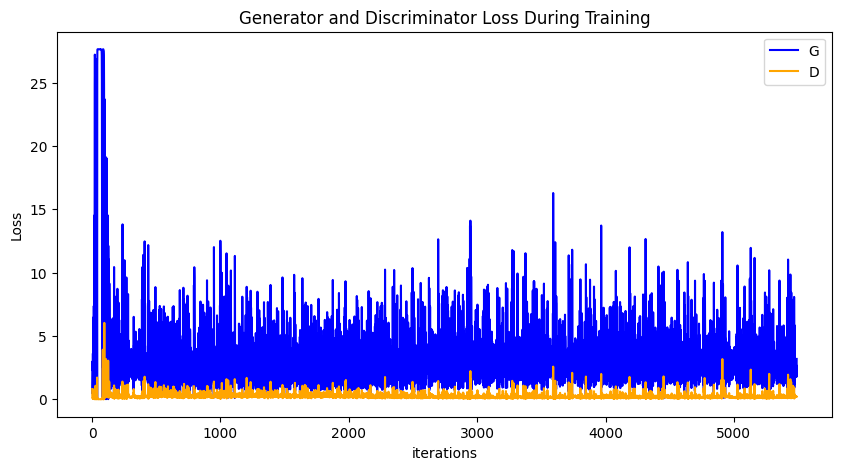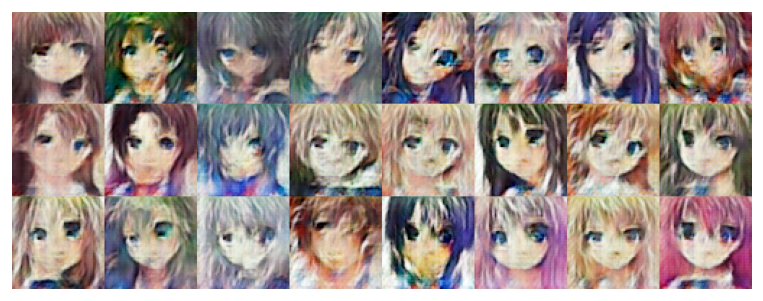Generating Cartoon Head Portrait via DCGAN
In the following tutorial, we will use sample code to show how to set up the network, optimizer, calculate the loss function, and initialize the model weight. This Anime Avatar Face Image Dataset contains 70,171 96 x 96 anime avatar face images.
GAN Basic Principle
For this part of the principle, refer to GAN image generation.
DCGAN Principle
Deep Convolutional Generative Adversarial Network (DCGAN) is a direct extension of GAN. The difference is that DCGAN uses convolution and transposed convolutional layers in the discriminator and generator, respectively.
It was first proposed by Radford et al. in paper Unsupervised Representation Learning With Deep Convolutional Generative Adversarial Networks. The discriminator consists of a hierarchical convolutional layer, a BatchNorm layer, and a LeakyReLU activation layer. Its input is a 3 x 64 x 64 image, and the output is the probability that the image is a real image. The generator consists of a transposed convolutional layer, a BatchNorm layer, and a ReLU activation layer. Its input is the implicit vector
This tutorial uses the anime face dataset to train a GAN, which is then used to generate anime avatar face images.
Data Preparation and Processing
First, download the dataset to the specified directory and decompress it. The sample code is as follows:
from download import download
url = "https://download.mindspore.cn/dataset/Faces/faces.zip"
path = download(url, "./faces", kind="zip", replace=True)
Downloading data from https://download.mindspore.cn/dataset/Faces/faces.zip (274.6 MB)
file_sizes: 100%|████████████████████████████| 288M/288M [00:33<00:00, 8.60MB/s]
Extracting zip file...
Successfully downloaded / unzipped to ./faces
The directory structure of the downloaded dataset is as follows:
./faces/faces
├── 0.jpg
├── 1.jpg
├── 2.jpg
├── 3.jpg
├── 4.jpg
...
├── 70169.jpg
└── 70170.jpg
Data Processing
First, define some inputs for the execution process:
batch_size = 128 # Batch size
image_size = 64 # Size of the training image
nc = 3 # Number of color channels
nz = 100 # Length of the implicit vector
ngf = 64 # Size of the feature map in the generator
ndf = 64 # Size of the feature map in the discriminator
num_epochs = 10 # Number of training epochs
lr = 0.0002 # Learning rate
beta1 = 0.5 # Beta 1 hyperparameter of the Adam optimizer
Define the create_dataset_imagenet function to process and augment data.
import numpy as np
import mindspore.dataset as ds
import mindspore.dataset.vision as vision
def create_dataset_imagenet(dataset_path):
"""Data loading"""
dataset = ds.ImageFolderDataset(dataset_path,
num_parallel_workers=4,
shuffle=True,
decode=True)
# Data augmentation
transforms = [
vision.Resize(image_size),
vision.CenterCrop(image_size),
vision.HWC2CHW(),
lambda x: ((x / 255).astype("float32"))
]
# Data mapping
dataset = dataset.project('image')
dataset = dataset.map(transforms, 'image')
# Batch operation
dataset = dataset.batch(batch_size)
return dataset
dataset = create_dataset_imagenet('./faces')
Use the create_dict_iterator function to convert data into a dictionary iterator, and then use the matplotlib module to visualize some training data.
import matplotlib.pyplot as plt
def plot_data(data):
# Visualize some traing data.
plt.figure(figsize=(10, 3), dpi=140)
for i, image in enumerate(data[0][:30], 1):
plt.subplot(3, 10, i)
plt.axis("off")
plt.imshow(image.transpose(1, 2, 0))
plt.show()
sample_data = next(dataset.create_tuple_iterator(output_numpy=True))
plot_data(sample_data)

Setting Up a GAN
After the data is processed, you can set up a GAN. According to the DCGAN paper, all model weights should be randomly initialized from a normal distribution with mean of 0 and sigma of 0.02.
Generator
Generator G maps the implicit vector z to the data space. Because the data is an image, this process also creates an RGB image with the same size as the real image. In practice, this function is implemented by using a series of Conv2dTranspose transposed convolutional layers. Each layer is paired with the BatchNorm2d layer and ReLu activation layer. The output data passes through the tanh function and returns a value within the data range of [-1,1].
The following shows the image generated by DCGAN:

The generator structure in the code is determined by nz, ngf, and nc set in the input. nz is the length of implicit vector z, ngf determines the size of the feature map propagated by the generator, and nc is the number of channels in the output image.
The code implementation of the generator is as follows:
import mindspore as ms
from mindspore import nn, ops
from mindspore.common.initializer import Normal
weight_init = Normal(mean=0, sigma=0.02)
gamma_init = Normal(mean=1, sigma=0.02)
class Generator(nn.Cell):
"""DCGAN Network Generator"""
def __init__(self):
super(Generator, self).__init__()
self.generator = nn.SequentialCell(
nn.Conv2dTranspose(nz, ngf * 8, 4, 1, 'valid', weight_init=weight_init),
nn.BatchNorm2d(ngf * 8, gamma_init=gamma_init),
nn.ReLU(),
nn.Conv2dTranspose(ngf * 8, ngf * 4, 4, 2, 'pad', 1, weight_init=weight_init),
nn.BatchNorm2d(ngf * 4, gamma_init=gamma_init),
nn.ReLU(),
nn.Conv2dTranspose(ngf * 4, ngf * 2, 4, 2, 'pad', 1, weight_init=weight_init),
nn.BatchNorm2d(ngf * 2, gamma_init=gamma_init),
nn.ReLU(),
nn.Conv2dTranspose(ngf * 2, ngf, 4, 2, 'pad', 1, weight_init=weight_init),
nn.BatchNorm2d(ngf, gamma_init=gamma_init),
nn.ReLU(),
nn.Conv2dTranspose(ngf, nc, 4, 2, 'pad', 1, weight_init=weight_init),
nn.Tanh()
)
def construct(self, x):
return self.generator(x)
generator = Generator()
Discriminator
As described above, discriminator D is a binary network model, and outputs the probability that the image is determined as a real image. It is processed through a series of Conv2d, BatchNorm2d, and LeakyReLU layers and obtains the final probability through the Sigmoid activation function.
The DCGAN paper mentions that using convolution instead of pooling for downsampling is a good way because it allows the network to learn its own pooling characteristics.
The code implementation of the discriminator is as follows:
class Discriminator(nn.Cell):
"""DCGAN discriminator"""
def __init__(self):
super(Discriminator, self).__init__()
self.discriminator = nn.SequentialCell(
nn.Conv2d(nc, ndf, 4, 2, 'pad', 1, weight_init=weight_init),
nn.LeakyReLU(0.2),
nn.Conv2d(ndf, ndf * 2, 4, 2, 'pad', 1, weight_init=weight_init),
nn.BatchNorm2d(ngf * 2, gamma_init=gamma_init),
nn.LeakyReLU(0.2),
nn.Conv2d(ndf * 2, ndf * 4, 4, 2, 'pad', 1, weight_init=weight_init),
nn.BatchNorm2d(ngf * 4, gamma_init=gamma_init),
nn.LeakyReLU(0.2),
nn.Conv2d(ndf * 4, ndf * 8, 4, 2, 'pad', 1, weight_init=weight_init),
nn.BatchNorm2d(ngf * 8, gamma_init=gamma_init),
nn.LeakyReLU(0.2),
nn.Conv2d(ndf * 8, 1, 4, 1, 'valid', weight_init=weight_init),
)
self.adv_layer = nn.Sigmoid()
def construct(self, x):
out = self.discriminator(x)
out = out.reshape(out.shape[0], -1)
return self.adv_layer(out)
discriminator = Discriminator()
Model Training
Loss Function
When D and G are defined, the binary cross-entropy loss function BCELoss defined in MindSpore will be used.
# Define loss function
adversarial_loss = nn.BCELoss(reduction='mean')
Optimizer
Two separate optimizers are set up here, one for D and the other for G. Both are Adam optimizers with lr = 0.0002 and beta1 = 0.5.
# Set optimizers for the generator and discriminator, respectively.
optimizer_D = nn.Adam(discriminator.trainable_params(), learning_rate=lr, beta1=beta1)
optimizer_G = nn.Adam(generator.trainable_params(), learning_rate=lr, beta1=beta1)
optimizer_G.update_parameters_name('optim_g.')
optimizer_D.update_parameters_name('optim_d.')
Training Model
Training is divided into two parts: discriminator training and generator training.
Train the discriminator.
The discriminator is trained to improve the probability of discriminating real images to the greatest extent. According to Goodfellow's approach, we can update the discriminator by increasing its stochastic gradient so as to maximize the value of
Train the generator.
As stated in the DCGAN paper, we want to train the generator by minimizing the value of
In the preceding two processes, the training loss is obtained, and statistics are collected at the end of each epoch. A batch of fixed_noise is pushed to the generator to intuitively trace the training progress of G.
The following implements the model training forward logic:
def generator_forward(real_imgs, valid):
# Sample noise as generator input
z = ops.standard_normal((real_imgs.shape[0], nz, 1, 1))
# Generate a batch of images
gen_imgs = generator(z)
# Loss measures generator's ability to fool the discriminator
g_loss = adversarial_loss(discriminator(gen_imgs), valid)
return g_loss, gen_imgs
def discriminator_forward(real_imgs, gen_imgs, valid, fake):
# Measure discriminator's ability to classify real from generated samples
real_loss = adversarial_loss(discriminator(real_imgs), valid)
fake_loss = adversarial_loss(discriminator(gen_imgs), fake)
d_loss = (real_loss + fake_loss) / 2
return d_loss
grad_generator_fn = ms.value_and_grad(generator_forward, None,
optimizer_G.parameters,
has_aux=True)
grad_discriminator_fn = ms.value_and_grad(discriminator_forward, None,
optimizer_D.parameters)
@ms.jit
def train_step(imgs):
valid = ops.ones((imgs.shape[0], 1), mindspore.float32)
fake = ops.zeros((imgs.shape[0], 1), mindspore.float32)
(g_loss, gen_imgs), g_grads = grad_generator_fn(imgs, valid)
optimizer_G(g_grads)
d_loss, d_grads = grad_discriminator_fn(imgs, gen_imgs, valid, fake)
optimizer_D(d_grads)
return g_loss, d_loss, gen_imgs
The network is trained cyclically, and the losses of the generator and discriminator are collected after every 50 iterations to facilitate the image of the loss function later in the training process.
import mindspore
G_losses = []
D_losses = []
image_list = []
total = dataset.get_dataset_size()
iterator = dataset.create_tuple_iterator(num_epochs=num_epochs)
for epoch in range(num_epochs):
generator.set_train()
discriminator.set_train()
# Read in data for each training round
for i, (imgs, ) in enumerate(iterator):
g_loss, d_loss, gen_imgs = train_step(imgs)
if i % 100 == 0 or i == total - 1:
# Output training records
print('[%2d/%d][%3d/%d] Loss_D:%7.4f Loss_G:%7.4f' % (
epoch + 1, num_epochs, i + 1, total, d_loss.asnumpy(), g_loss.asnumpy()))
D_losses.append(d_loss.asnumpy())
G_losses.append(g_loss.asnumpy())
# After each epoch, use the generator to generate a set of images
generator.set_train(False)
fixed_noise = ops.standard_normal((batch_size, nz, 1, 1))
img = generator(fixed_noise)
image_list.append(img.transpose(0, 2, 3, 1).asnumpy())
# Save the network model parameters as a ckpt file
mindspore.save_checkpoint(generator, "./generator.ckpt")
mindspore.save_checkpoint(discriminator, "./discriminator.ckpt")
[ 1/10][ 1/549] Loss_D: 0.8013 Loss_G: 0.5065
[ 1/10][101/549] Loss_D: 0.1116 Loss_G:13.0030
[ 1/10][201/549] Loss_D: 0.1037 Loss_G: 2.5631
...
[ 1/10][401/549] Loss_D: 0.6240 Loss_G: 0.5548
[ 1/10][501/549] Loss_D: 0.3345 Loss_G: 1.6001
[ 1/10][549/549] Loss_D: 0.4250 Loss_G: 1.1978
...
[10/10][501/549] Loss_D: 0.2898 Loss_G: 1.5352
[10/10][549/549] Loss_D: 0.2120 Loss_G: 3.1816
Results
Run the following code to depict a plot of D and G losses versus training iterations:
plt.figure(figsize=(10, 5))
plt.title("Generator and Discriminator Loss During Training")
plt.plot(G_losses, label="G", color='blue')
plt.plot(D_losses, label="D", color='orange')
plt.xlabel("iterations")
plt.ylabel("Loss")
plt.legend()
plt.show()

Visualize the images generated by the hidden vector fixed_noise during the training process.
import matplotlib.pyplot as plt
import matplotlib.animation as animation
def showGif(image_list):
show_list = []
fig = plt.figure(figsize=(8, 3), dpi=120)
for epoch in range(len(image_list)):
images = []
for i in range(3):
row = np.concatenate((image_list[epoch][i * 8:(i + 1) * 8]), axis=1)
images.append(row)
img = np.clip(np.concatenate((images[:]), axis=0), 0, 1)
plt.axis("off")
show_list.append([plt.imshow(img)])
ani = animation.ArtistAnimation(fig, show_list, interval=1000, repeat_delay=1000, blit=True)
ani.save('./dcgan.gif', writer='pillow', fps=1)
showGif(image_list)

From the image above, we can see that the image quality is getting better as the number of training cycles increases. If we increase the number of training cycles, when num_epochs reaches above 50, the generated anime avatar images are more similar to those in the dataset. We generate the images by loading the generator network model parameter file below with the following code:
# Get the model parameters from the file and load them into the network
mindspore.load_checkpoint("./generator.ckpt", generator)
fixed_noise = ops.standard_normal((batch_size, nz, 1, 1))
img64 = generator(fixed_noise).transpose(0, 2, 3, 1).asnumpy()
fig = plt.figure(figsize=(8, 3), dpi=120)
images = []
for i in range(3):
images.append(np.concatenate((img64[i * 8:(i + 1) * 8]), axis=1))
img = np.clip(np.concatenate((images[:]), axis=0), 0, 1)
plt.axis("off")
plt.imshow(img)
plt.show()

